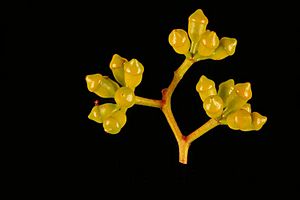Yellowjack facts for kids
Quick facts for kids Yellowjack |
|
|---|---|
| Scientific classification | |
| Genus: |
Corymbia
|
| Species: |
bloxsomei
|
| Synonyms | |
|
Eucalyptus bloxsomei Maiden |
|
The Yellowjack tree, also called yellow jacket or yellow bloodwood, is a special type of tree found only in inland, south-eastern Queensland, Australia. Its scientific name is Corymbia bloxsomei. This tree has thick, rough bark that looks scaly on its trunk and big branches. Its leaves are long and curved, and its flowers are creamy white or light yellow. After flowering, it grows interesting barrel-shaped or round fruits.
Contents
What Does the Yellowjack Tree Look Like?
The Yellowjack tree usually grows to be about 15 to 24 m (49 to 79 ft) tall. That's like a five to eight-story building! It has a special woody swelling at its base called a lignotuber. This helps the tree regrow if it gets damaged, like by a bushfire.
Its bark is soft, rough, and scaly, or it can look like a puzzle (tessellated). It's usually yellowish to brownish and covers the trunk and most of the branches.
- Young leaves: When the tree is young, or when new shoots grow from the base (called coppice regrowth), the leaves are paler underneath. They are shaped like an egg or an oval, about 70 to 140 mm (2.8 to 5.5 in) long and 38 to 60 mm (1.5 to 2.4 in) wide.
- Adult leaves: Older leaves are shiny green on both sides. They are shaped like a spear or are slightly curved, measuring about 110 to 188 mm (4.3 to 7.4 in) long and 10 to 35 mm (0.39 to 1.38 in) wide. They narrow down to a stalk called a petiole, which is about 13 to 35 mm (0.51 to 1.38 in) long.
The tree's flower buds grow in groups of seven, nine, or eleven. They are found at the ends of the branches on a main stalk called a peduncle, which is about 4 to 23 mm (0.16 to 0.91 in) long. Each bud has its own small stalk, or pedicel, about 1 to 7 mm (0.039 to 0.276 in) long.
- Flower buds: When the buds are ready to open, they are oval to cylinder-shaped, about 9 mm (0.35 in) long and 7 mm (0.28 in) wide. They have a cap-like lid called an operculum that pops off when the flower blooms.
- Flowers: Yellowjack trees have been seen flowering in June and December. Their flowers are a lovely creamy white to pale yellow color.
- Fruit: After the flowers, the tree produces a woody fruit. It's a capsule that can be shaped like a barrel, an urn, or a sphere. These fruits are about 12 to 18 mm (0.47 to 0.71 in) long and 9 to 13 mm (0.35 to 0.51 in) wide. The parts that release the seeds are hidden inside the fruit.
How Did the Yellowjack Tree Get Its Name?
The Yellowjack tree was first officially described in 1925 by a botanist named Joseph Maiden. He gave it the name Eucalyptus bloxsomei.
Later, in 1995, two other botanists, Ken Hill and Lawrie Johnson, decided to change its name to Corymbia bloxsomei. The second part of its scientific name, bloxsomei, was chosen to honor someone named Herbert Schreiber Bloxsome.
Where Does the Yellowjack Tree Grow?
The Yellowjack tree grows in forests. You can find it on flat areas or on gentle slopes in Queensland, Australia. It grows from places near Mundubbera all the way to Chinchilla. It's especially common in the Barakula State Forest. Remember, it's found only in this specific part of the world!
Is the Yellowjack Tree Endangered?
Good news! The Yellowjack tree is not considered to be in danger. The Government of Queensland has classified it as being of "least concern" under their Nature Conservation Act 1992. This means there are plenty of these trees around, and they are not currently at risk of disappearing.


